Inhibitory Activity of 4-Benzylidene Oxazolones Derivatives of Cinnamic Acid on Human Acetylcholinesterase and Cognitive Improvements in a Mouse Model
Abstract
:1. Introduction
2. Results and Discussion
2.1. hAChE Inhibitory Screening
2.2. Evaluation of Kinetics
2.3. Estimation of IC50 Values
2.4. Molecular Modelling
2.5. In Silico Assessment of Blood–Brain Barrier (BBB) Permeation
2.6. In Vivo Learning and Memory Tests
2.6.1. The Spontaneous Alternation Test
2.6.2. Spatial Working Memory
2.6.3. Recognition Memory
3. Materials and Methods
3.1. Chemicals
3.2. Synthesis and Characterization of Oxazolones
- 4-((Z)-R-benzylidene)-2-((E)-styryl)oxazol-5(4H)-one ((1)–(7)) [11,16,36]: Cinnamoylglycine (2.0 g, 9.7 mmol), sodium acetate (0.69 g, 8.5 mmol), the corresponding aromatic aldehyde (11.5 mmol), and acetic anhydride (4.5 mL) were refluxed for 1 h. Following the removal of solvent, the residue was washed with cold ethanol and dried to give a yellow solid.
- 4-((Z)-benzylidene)-2-((E)-styryl)oxazol-5(4H)-one (1). Yellow solid, yield 34%; mp 124–126 °C; Rf = 0.64 (PE: DCM) (1:1); FTIR (ATR, neat): ν/cm−1 3056 (CH, Ar), 3028 (CH, Ar), 1783 (C=O, lactone), 1648 (C=N, imine); 1H-NMR (400 MHz, CDCl3) δ 8.13 (m, 2H, Ar), 7.71 (d, J 16.0 Hz, 1H, CH), 7.59 (m, 2H, Ar), 7.44 (m, 6H, Ar), 7.20 (s, 1H, CH), 6.83 (d, J 16.0 Hz, 1H); 13C-NMR (100 MHz, CDCl3) δ 167.3, 163.4, 143.9, 134.6, 133.6, 132.3, 131.3, 131.1, 130.7, 129.1, 128.9, 128.2, 113.4; EM m/z; C18H14NO2, [M+1]+ 276. HRMS (EI) m/z calcd. For C18H14NO2 [M + 1]+ 276.1025, found 276.10245
- 4-((Z)-4-methylbenzylidene)-2-((E)-styryl)oxazol-5(4H)-one (2). Yellow solid, yield 34%; mp 156–158 °C; Rf = 0.67 (PE: DCM) (1:1); FTIR (ATR, neat) ν/cm−1 3028 (CH, Ar), 1778 (C=O, lactone), 1655 (C=N, imine), 1367 (C-H, CH3); 1H-NMR (400 MHz, CDCl3) δ 8.03 (d, J 8.0 Hz, 2H, Ar), 7.69 (d, J 16.0 Hz, 1H, CH), 7.58 (m, 2H, Ar), 7.43 (m, 3H, Ar), 7.26 (d, J 8.0 Hz, 2 H, Ar) 7.18 (s, 1H, CH), 6.82 (d, J 16.0 Hz, 1H, CH), 2.41 (s, 3H, CH); 13C-NMR (100 MHz, CDCl3) δ 167.1, 162.9, 143.5, 142.0, 134.7, 132.8, 132.3, 131.6, 130.9, 130.6, 129.7, 129.1, 128.1, 113.5, 21.7; EM m/z; C19H16NO2, [M + 1]+ 290. HRMS (EI) m/z calcd. For C19H16NO2 [M+1]+ 290.1181, found 290.11810
- 4-((Z)-4-chlorobenzylidene)-2-((E)-styryl)oxazol-5(4H)-one (3). Yellow solid, yield 59%; mp166–168 °C; Rf = 0.57 (PE: DCM) (1:1); FTIR (ATR, neat) ν/cm−1 3032 (C-H, Ar), 1784 (C=O, lactone), 1654 (C=N, imine); 1H-NMR (400 MHz, CDCl3) δ 8.08 (d, J 8.0 Hz, 2H, Ar), 7.72 (d, J 16.0 Hz, 1H, CH), 7.59 (m, 2H, Ar), 7.43 (m, 5H, Ar), 7.13 (s, 1H, CH), 6.82 (d, J16.0 Hz, 1H, CH); 13C-NMR (100 MHz, CDCl3) δ 167.05, 163.7, 144.3, 137.2, 134.5, 133.9, 133.3, 132.1, 130.9, 129.5, 129.2, 129.1, 128.2, 113.2; EM m/z; C18H13 ClNO2, [M+1]+ 310. HRMS (EI) m/z calcd. For C18H13ClNO2 [M + 1]+ 310.635, found 310.06348
- 4-((Z)-4-methoxybenzylidene)-2-((E)-styryl)oxazol-5(4H)-one (4). Yellow solid, yield 66%; mp168–170 °C; Rf = 0.82 (DCM); FTIR (ATR, neat) ν/cm−1 3071 (C-H, Ar), 3029 (C-H, Ar), 1776 (C=O, lactone), 1651 (C=N, imine); 1H-NMR (400 MHz, CDCl3) δ 8.12 (d, J 8.8 Hz, 2H, Ar), 7.67 (d, J 16.0 Hz, 1H, CH), 7.58 (m, 2H, Ar), 7.42 (m, 3H, Ar), 7.16 (s, 1H, CH), 6.98 (d, J 9.0 Hz, 2H, Ar), 6.81 (d, J 16.0 Hz, 1H, CH), 3.88 (s, 3H, CH); 13C-NMR (100 MHz, CDCl3) δ 167.6, 162.4, 162.2, 143.0, 134.7, 134.4, 131.4, 130.5, 129.1, 128.9, 128.0, 126.6, 114.5, 113.5, 55.4; EM m/z; C19H16NO3, [M+1]+ 306. HRMS (EI) m/z calcd. For C19H16NO3 [M + 1]+ 306.1130, found 306.11302
- 3-((Z)-(5-oxo-2-((E)-styryl)oxazol-4(5H)-ylidene)methyl)phenyl acetate (5). Yellow solid, yield 37%; mp152 °C; Rf = 0.97 (DCM); FTIR (ATR, neat): ν/cm−1 3074 (CH, Ar), 3035 (CH, Ar), 1783 (C=O, lactone), 1648 (C=N, imine); 1H-NMR (400 MHz, CDCl3) δ 7.98 (m, 1H, Ar), 7.18 (m, 1H, Ar), 7.72 (d, J 16 Hz, 1H, CH), 7.60 (m, 2H, Ar), 7.46 (s, 1H, Ar), 7.43(m, 3H, Ar), 7.23 (m, 2H, Ar), 7.15 (s, 1H, CH), 6.83 (d, J 16 Hz, 1H, CH), 2.34 (s, 3H, CH); 13C-NMR (100 MHz, CDCl3) δ 169.2, 167.0, 163.8, 151.0, 144.3, 135.0, 134.5, 134.3, 130.9, 129.8, 129.7, 129.1, 128.2, 124.7, 124.3, 113.3, 21.1; EM m/z; C20H16NO4, [M+1]+ 334. HRMS (EI) m/z calcd. For C20H16NO4 [M + 1]+ 334.1079, found 334.107930
- 4-((Z)-(5-oxo-2-((E)-styryl)oxazol-4(5H)-ylidene)methyl)phenyl acetate (6). Yellow solid, yield 35%; mp=170 °C; Rf = 0.94 (DCM); FTIR (ATR, neat): ν/cm−1 3029 (C-H, Ar), 3024 (C-H, Ar), 3000 (C-H, Ar), 1706 (C=O, lactone), 1670 (C=N, imine); 1H-NMR (400 MHz, CDCl3) δ 8.17 (d, J 8 Hz, 2H, Ar), 7.71 (d, J 16 Hz, 1H, CH), 7.59 (m, 2H, Ar), 7.43 (m, 3H, Ar), 7.21 (m, 2H, Ar), 7.16 (s, 1H, CH), 6.82 (d, J 16, 1H, CH), 2.32 (s, 3H, CH); 13C-NMR (100 MHz, CDCl3) δ 168.9, 167.2, 163.5, 152.6, 144.0, 134.6, 133.5, 131.3, 130.5, 130.8, 130.0, 129.1, 128.2, 122.1, 113.3, 21.4; EM m/z; C20H16NO4, [M + 1]+ 334. HRMS (EI) m/z calcd. For C20H16NO4 [M+1]+ 334.1079, found 334.10793
- 2-hydroxy-3-((Z)-(5-oxo-2-((E)-styryl)oxazol-4(5H)-ylidene)methyl)phenyl acetate (7). Yellow solid, yield 35%; mp 160 °C; Rf = 0.10 (DCM); FTIR (ATR, neat): ν/cm−1 3029 (CH, Ar), 1783 (C=O, lactone), 1655 (C=N, imine); 1H-NMR (400 MHz, CDCl3) δ 8.83 (s, 1H, CH=), 8.22 (s, 1H, CH=), 7.77 (d, J 15.5 Hz, 1H, CH=), 7.57 (m, 2H, Ar), 7.42 (m, 4H, Ar), 7.31 (d, 1H, Ar), 7.21 (m, 1H, Ar), 6.60 (d, J 15.6 Hz, 1H, CH=), 2.42 (s, 3H, CH); 13C-NMR (100 MHz, CDCl3) δ 168.5, 164.8, 157.8, 143.7, 141.6, 137.6, 134.2, 130.5, 129.0, 128.2, 125.3, 125.0, 124.6, 123.2, 123.1, 121.3, 119.7, 20.6; EM m/z; C20H16NO5, [M+1]+ 350. HRMS (EI) m/z calcd. For C20H16NO5 [M + 1]+ 350.1028, found 350.10285
3.3. Enzyme Preparation
3.4. hAChE Inhibitory Screening
3.5. Kinetic Determinations
3.6. Estimation of IC50 Values
3.7. Molecular Modelling
3.8. In Silico Assessment of Blood–Brain Barrier (BBB) Permeability
3.9. In Vivo Cognitive Tests
3.9.1. Animal Model
3.9.2. Amnesia Induced Pharmacologically
3.9.3. The Spontaneous Alternation Test
3.9.4. Spatial Working Memory
3.9.5. Recognition Memory
3.9.6. Statistics
4. Conclusions
Supplementary Materials
Author Contributions
Funding
Institutional Review Board Statement
Data Availability Statement
Conflicts of Interest
References
- Sharma, K. Cholinesterase Inhibitors as Alzheimer’s Therapeutics (Review). Mol. Med. Rep. 2019, 20, 1479–1487. [Google Scholar] [CrossRef]
- Thapa, S.; Lv, M.; Xu, H. Acetylcholinesterase: A Primary Target for Drugs and Insecticides. Mini Rev. Med. Chem. 2017, 17, 1665–1676. [Google Scholar] [CrossRef]
- Aroniadou-Anderjaska, V.; Apland, J.P.; Figueiredo, T.H.; De Araujo Furtado, M.; Braga, M.F. Acetylcholinesterase Inhibitors (Nerve Agents) as Weapons of Mass Destruction: History, Mechanisms of Action, and Medical Countermeasures. Neuropharmacology 2020, 181, 108298. [Google Scholar] [CrossRef]
- Gerlits, O.; Blakeley, M.P.; Keen, D.A.; Radić, Z.; Kovalevsky, A. Room Temperature Crystallography of Human Acetylcholinesterase Bound to a Substrate Analogue 4K-TMA: Towards a Neutron Structure. Curr. Res. Struct. Biol. 2021, 3, 206–215. [Google Scholar] [CrossRef] [PubMed]
- Cavas, L.; Topcam, G.; Gundogdu-Hizliates, C.; Ergun, Y. Neural Network Modeling of AChE Inhibition by New Carbazole-Bearing Oxazolones. Interdiscip. Sci. Comput. Life Sci. 2019, 11, 95–107. [Google Scholar] [CrossRef] [PubMed]
- Eckroat, T.J.; Manross, D.L.; Cowan, S.C. Merged Tacrine-Based, Multitarget-Directed Acetylcholinesterase Inhibitors 2015–Present: Synthesis and Biological Activity. Int. J. Mol. Sci. 2020, 21, 5965. [Google Scholar] [CrossRef] [PubMed]
- Bortolami, M.; Pandolfi, F.; Tudino, V.; Messore, A.; Madia, V.N.; De Vita, D.; Di Santo, R.; Costi, R.; Romeo, I.; Alcaro, S.; et al. New Pyrimidine and Pyridine Derivatives as Multitarget Cholinesterase Inhibitors: Design, Synthesis, and in Vitro and in Cellulo Evaluation. ACS Chem. Neurosci. 2021, 12, 4090–4112. [Google Scholar] [CrossRef]
- Haneen, D.S.A.; Abou-Elmagd, W.S.I.; Youssef, A.S.A. 5(4H)-Oxazolones: Synthesis and Biological Activities. Synth. Commun. 2021, 51, 215–233. [Google Scholar] [CrossRef]
- Albelwi, F.F.; Al-anazi, M.; Naqvi, A.; Hritani, Z.M.; Okasha, R.M.; Afifi, T.H.; Hagar, M. Novel Oxazolones Incorporated Azo Dye: Design, Synthesis Photophysical-DFT Aspects and Antimicrobial Assessments with In-Silico and In-Vitro Surveys. J. Photochem. Photobiol. 2021, 7, 100032. [Google Scholar] [CrossRef]
- de Castro, P.P.; Carpanez, A.G.; Amarante, G.W. Azlactone Reaction Developments. Chem.-A Eur. J. 2016, 22, 10294–10318. [Google Scholar] [CrossRef]
- Rambabu, B.; Priyanka, B.; Rao, N.K. Desing, Synthesis and Biological Evaluation of a Novel Serioes of Oxazolones Promoted by K3PO4 Catalyst. World J. Pharm. Res. 2023, 12, 916–928. [Google Scholar]
- Mariappan, G.; Saha, B.P.; Datta, S.; Kumar, D.; Haldar, P.K. Design, Synthesis and Antidiabetic Evaluation of Oxazolone Derivatives. J. Chem. Sci. 2011, 123, 335–341. [Google Scholar] [CrossRef]
- Choi, D.I.; Choi, J.Y.; Kim, Y.J.; Lee, J.B.; Kim, S.O.; Shin, H.T.; Lee, S.C. Ethanol Extract of Peanut Sprout Exhibits a Potent Anti-Inflammatory Activity in Both an Oxazolone-Induced Contact Dermatitis Mouse Model and Compound 48/80-Treated HaCaT Cells. Ann. Dermatol. 2015, 27, 142–151. [Google Scholar] [CrossRef] [PubMed]
- Hamidian, H.; Azizi, S. Synthesis of Novel Compounds Containing Morpholine and 5(4H)-Oxazolone Rings as Potent Tyrosinase Inhibitors. Bioorganic Med. Chem. 2015, 23, 7089–7094. [Google Scholar] [CrossRef]
- Abdel-Aty, A.S. Pesticidal Effects of Some Imidazolidine and Oxazolone Derivatives. World J. Agric. Sci. 2009, 5, 105–113. [Google Scholar]
- Mustafa, A.; Asker, W.; Harhash, A.H.; Abdin, T.M.S.; Zayed, E.M. Reaktionen mit 2.4-disubstituierten Δ2-Oxazolinonen-(5). Liebigs Ann. Chem. 1968, 714, 146–154. [Google Scholar] [CrossRef]
- Maraković, N.; Knežević, A.; Vinković, V.; Kovarik, Z.; Šinko, G. Design and Synthesis of N-Substituted-2-Hydroxyiminoacetamides and Interactions with Cholinesterases. Chem. Biol. Interact. 2016, 259, 122–132. [Google Scholar] [CrossRef]
- Copeland, R.A. Evaluation of Enzyme Inhibitors in Drug Discovery: A Guide for Medicinal Chemists and Pharmacologists, 2nd ed.; Wiley, Ed.; John Wiley & Sons, Inc.: Hoboken, NJ, USA, 2013; ISBN 978-1-118-48813-3. [Google Scholar]
- Hevener, K.E.; Zhao, W.; Ball, D.M.; Babaoglu, K.; Qi, J.; White, S.W.; Lee, R.E. Validation of Molecular Docking Programs for Virtual Screening against Dihydropteroate Synthase. J. Chem. Inf. Model. 2009, 49, 444–460. [Google Scholar] [CrossRef]
- Kryger, G.; Silman, I.; Sussman, J.L. Structure of Acetylcholinesterase Complexed with E2020 (Ariceptρ): Implications for the Design of New Anti-Alzheimer Drugs. Structure 1999, 7, 297–307. [Google Scholar] [CrossRef]
- Ferreira Neto, D.C.; de Souza Ferreira, M.; da Conceição Petronilho, E.; Alencar Lima, J.; Oliveira Francisco de Azeredo, S.; de Oliveira Carneiro Brum, J.; Jorge do Nascimento, C.; Figueroa Villar, J.D. A New Guanylhydrazone Derivative as a Potential Acetylcholinesterase Inhibitor for Alzheimer’s Disease: Synthesis, Molecular Docking, Biological Evaluation and Kinetic Studies by Nuclear Magnetic Resonance. RSC Adv. 2017, 7, 33944–33952. [Google Scholar] [CrossRef]
- Radić, Z.; Reiner, E.; Taylor, P. Role of the Peripheral Anionic Site on Acetylcholinesterase: Inhibition by Substrates and Coumarin Derivatives. Mol. Pharmacol. 1991, 39, 98–104. [Google Scholar] [PubMed]
- Sepsova, V.; Karasova, J.Z.; Korabecny, J.; Dolezal, R.; Zemek, F.; Bennion, B.J.; Kuca, K. Oximes: Inhibitors of Human Recombinant Acetylcholinesterase. A Structure-Activity Relationship (SAR) Study. Int. J. Mol. Sci. 2013, 14, 16882–16900. [Google Scholar] [CrossRef] [PubMed]
- Saini, R.; Saxena, A.K. The Structural Hybrids of Acetylcholinesterase Inhibitors in the Treatment of Alzheimer’s Disease: A Review. Alzheimer’s Neurodegener. Dis. 2018, 4, 015. [Google Scholar] [CrossRef]
- Sanson, B.; Colletier, J.P.; Xu, Y.; Lang, P.T.; Jiang, H.; Silman, I.; Sussman, J.L.; Weik, M. Backdoor Opening Mechanism in Acetylcholinesterase Based on X-ray Crystallography and Molecular Dynamics Simulations. Protein Sci. 2011, 20, 1114–1118. [Google Scholar] [CrossRef]
- Colletier, J.P.; Royant, A.; Specht, A.; Sanson, B.; Nachon, F.; Masson, P.; Zaccai, G.; Sussman, J.L.; Goeldner, M.; Silman, I.; et al. Use of a ‘Caged’ Analogue to Study the Traffic of Choline within Acetylcholinesterase by Kinetic Crystallography. Acta Crystallogr. 2007, D63, 1115–1128. [Google Scholar] [CrossRef] [PubMed]
- Xu, Y.; Cheng, S.; Sussman, J.L.; Silman, I.; Jiang, H. Computational Studies on Acetylcholinesterases. Molecules 2017, 22, 1324. [Google Scholar] [CrossRef]
- Ali, J.; Camilleri, P.; Brown, M.B.; Hutt, A.J.; Kirton, S.B. Revisiting the General Solubility Equation: In Silico Prediction of Aqueous Solubility Incorporating the Effect of Topographical Polar Surface Area. J. Chem. Inf. Model. 2012, 52, 420–428. [Google Scholar] [CrossRef]
- Lipinski, C.A.; Lombardo, F.; Dominy, B.W.; Feeney, P.J. Experimental and Computational Approaches to Estimate Solubility and Permeability in Drug Discovery and Development Settings. Adv. Drug Deliv. Rev. 1997, 23, 3–25. [Google Scholar] [CrossRef]
- Arunrungvichian, K.; Boonyarat, C.; Fokin, V.V.; Taylor, P.; Vajragupta, O. Cognitive Improvements in a Mouse Model with Substituted 1,2,3-Triazole Agonists for Nicotinic Acetylcholine Receptors. ACS Chem. Neurosci. 2015, 6, 1331–1340. [Google Scholar] [CrossRef]
- Carlos, D.H.; Bibiana Roselly, C.R.; Angel, U.L.; Laura, M.A.; Kenya Karina, S.R.; Jose Manuel, C.B.; Alejandra, C.S.; Gabriela, C.C.E.; Estefanía, O.R.; Aracely, S.M. Cognitive Improvements in a Rat Model with Polyunsaturated Fatty Acids EPA and DHA through A7-Nicotinic Acetylcholine Receptors. Nutr. Neurosci. 2022, 25, 791–800. [Google Scholar] [CrossRef]
- Koob, G.F.; Gold, L.H.; Dellu, F.; Contarino, A.; Simon, H. Genetic Differences in Response to Novelty and Spatial Memory Using a Two-Trial Recognition Task in Mice. Neurobiol. Learn. Mem. 2002, 73, 31–48. [Google Scholar] [CrossRef]
- Stanford Medicine. Behavioral and Functional Neuroscience Laboratory. Available online: https://med.stanford.edu/sbfnl/services/bm/lm/bml-novel.html (accessed on 3 February 2023).
- Kendall, I.; Slotten, H.A.; Codony, X.; Burgueño, J.; Pauwels, P.J.; Vela, J.M.; Fone, K.C.F. E-6801, a 5-HT6 Receptor Agonist, Improves Recognition Memory by Combined Modulation of Cholinergic and Glutamatergic Neurotransmission in the Rat. Psychopharmacology 2011, 213, 413–430. [Google Scholar] [CrossRef] [PubMed]
- Gawel, K.; Labuz, K.; Gibula-Bruzda, E.; Jenda, M.; Marszalek-Grabska, M.; Filarowska, J.; Silberring, J.; Kotlinska, J.H. Cholinesterase Inhibitors, Donepezil and Rivastigmine, Attenuate Spatial Memory and Cognitive Flexibility Impairment Induced by Acute Ethanol in the Barnes Maze Task in Rats. Naunyn. Schmiedebergs. Arch. Pharmacol. 2016, 389, 1059–1071. [Google Scholar] [CrossRef]
- He, X.; Bell, A.F.; Tonge, P.J. Synthesis and Spectroscopic Studies of Model Red Fluorescent Protein Chromophores. Org. Lett. 2002, 4, 1523–1526. [Google Scholar] [CrossRef]
- Ellman, G.L.; Courtney, K.D.; Andres, V.; Featherstone, R.M. A New and Rapid Colorimetric Determination of Acetylcholinesterase Activity. Biochem. Pharmacol. 1961, 7, 88–95. [Google Scholar] [CrossRef]
- Fekonja, O.; Zorec-Karlovsek, M.; El Kharbili, M.; Fournier, D.; Stojan, J. Inhibition and Protection of Cholinesterases by Methanol and Ethanol. J. Enzym. Inhib. Med. Chem. 2007, 22, 407–415. [Google Scholar] [CrossRef] [PubMed]
- Lineweaver, H.; Burk, D. The Determination of Enzyme Dissociation Constants. J. Am. Chem. Soc. 1934, 56, 658–666. [Google Scholar] [CrossRef]
- Bosak, A.; Opsenica, D.M.; Šinko, G.; Zlatar, M.; Kovarik, Z. Structural Aspects of 4-Aminoquinolines as Reversible Inhibitors of Human Acetylcholinesterase and Butyrylcholinesterase. Chem. Biol. Interact. 2019, 308, 101–109. [Google Scholar] [CrossRef]
- Scheffel, C.; Thiermann, H.; Worek, F. Effect of Reversible Ligands on Oxime-Induced Reactivation of Sarin- and Cyclosarin-Inhibited Human Acetylcholinesterase. Toxicol. Lett. 2015, 232, 557–565. [Google Scholar] [CrossRef]
- Sanner, M.F. No TitlePython: A Programming Language for Software Integration and Development. J. Mol. Graph. Model. 1999, 17, 57–61. [Google Scholar]
- Pettersen, E.F.; Goddard, T.D.; Huang, C.C.; Couch, G.S.; Greenblatt, D.M.; Meng, E.C.; Ferrin, T.E. UCSF Chimera—A Visualization System for Exploratory Research and Analysis. J. Comput. Chem. 2004, 25, 1605–1612. [Google Scholar] [CrossRef] [PubMed]
- Wang, J.; Wang, W.; Kollman, P.A.; Case, D.A. Automatic Atom Type and Bond Type Perception in Molecular Mechanical Calculations. J. Mol. Graph. Model. 2006, 25, 247–260. [Google Scholar] [CrossRef] [PubMed]
- Daina, A.; Michielin, O.; Zoete, V. iLOGP: A Simple, Robust, and Efficient Description of n-Octanol/Water Partition Coefficient for Drug Design Using the GB/SA Approach. J. Chem. Inf. Model. 2014, 54, 3284–3301. [Google Scholar] [CrossRef] [PubMed]
- Daina, A.; Michielin, O.; Zoete, V. SwissADME: A Free Web Tool to Evaluate Pharmacokinetics, Drug-Likeness and Medicinal Chemistry Friendliness of Small Molecules. Sci. Rep. 2017, 7, 42717. [Google Scholar] [CrossRef]
- Pajouhesh, H.; Lenz, G.R. Medicinal Chemical Properties of Successful Central Nervous System Drugs. NeuroRX 2005, 2, 541–553. [Google Scholar] [CrossRef]
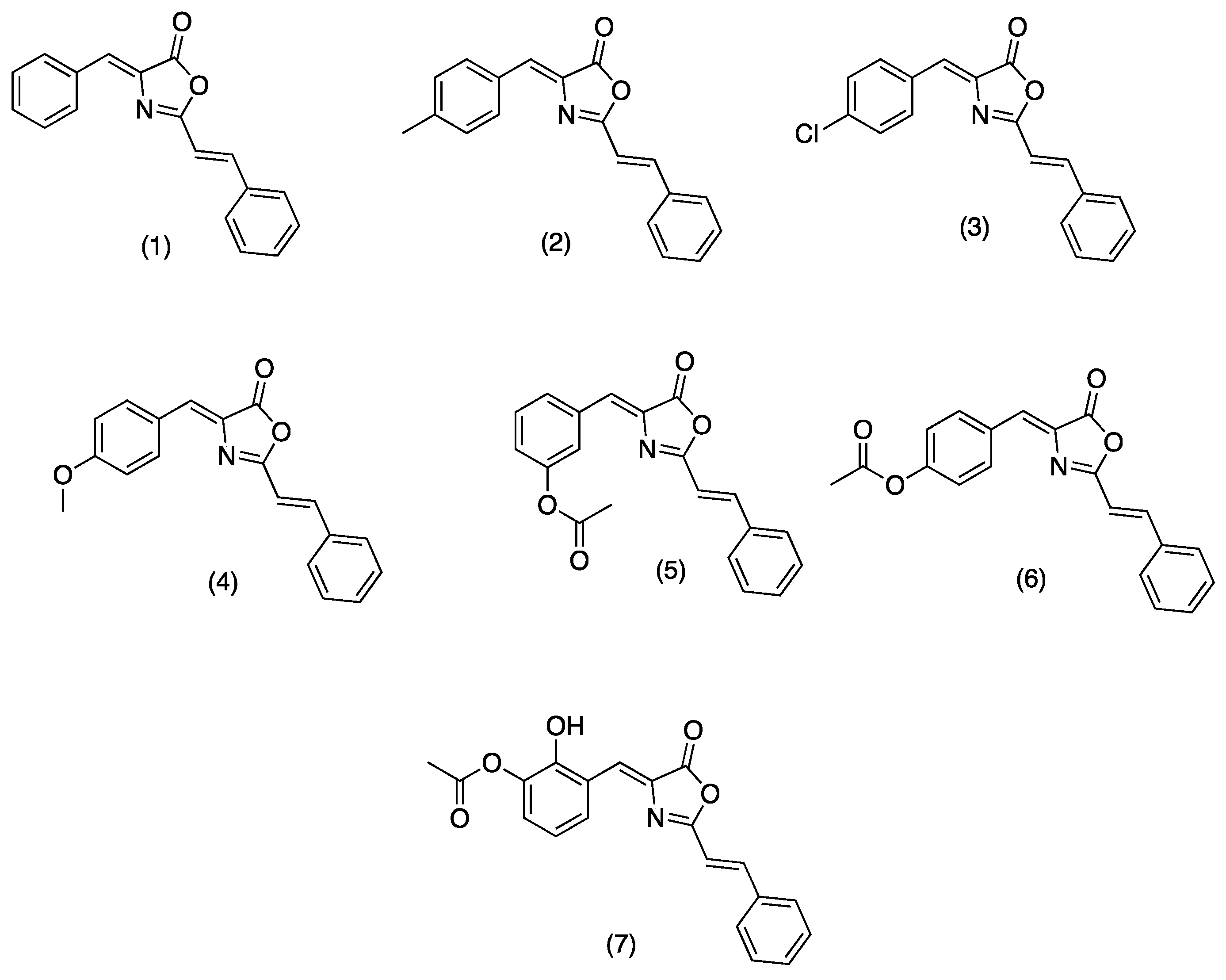
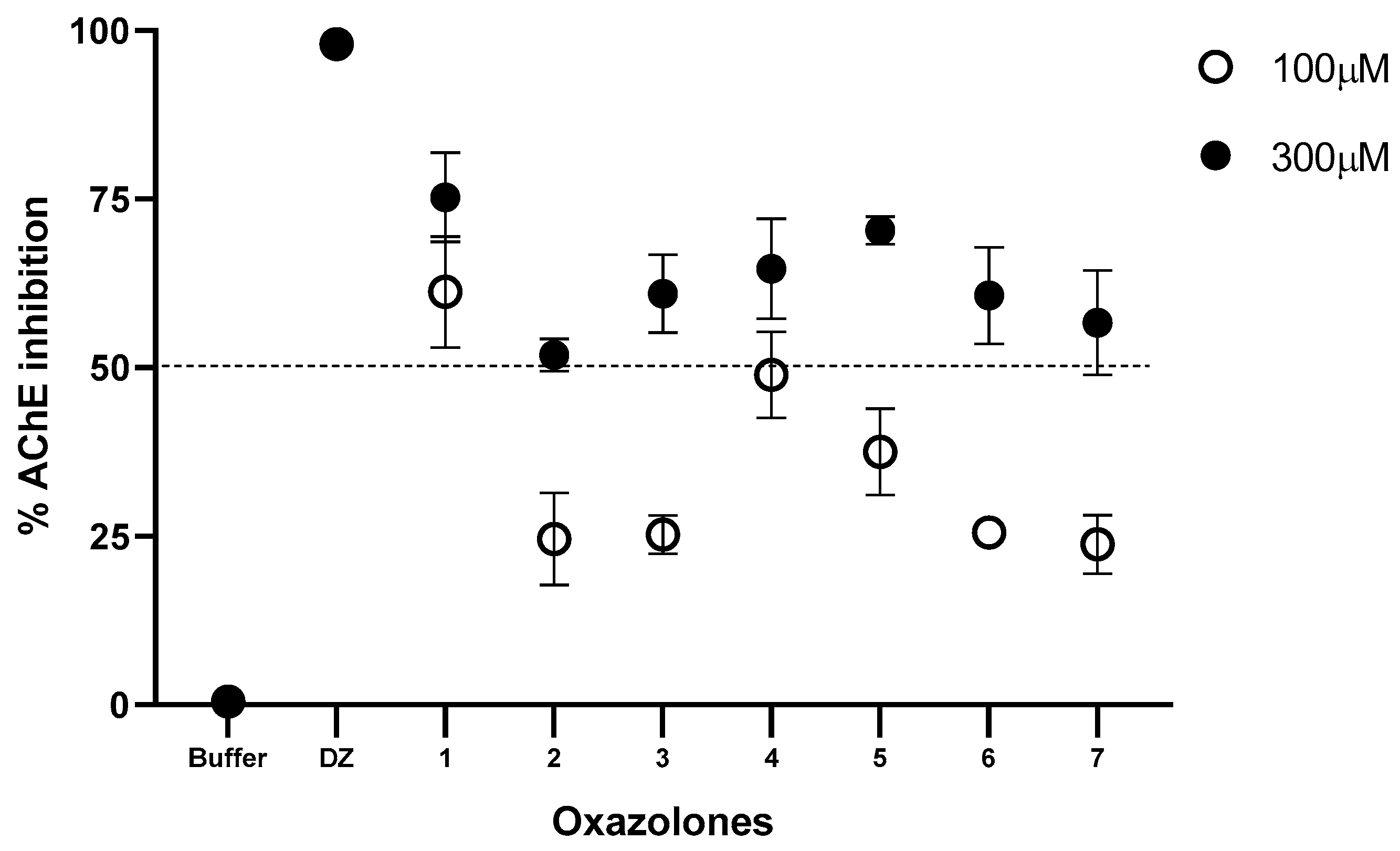
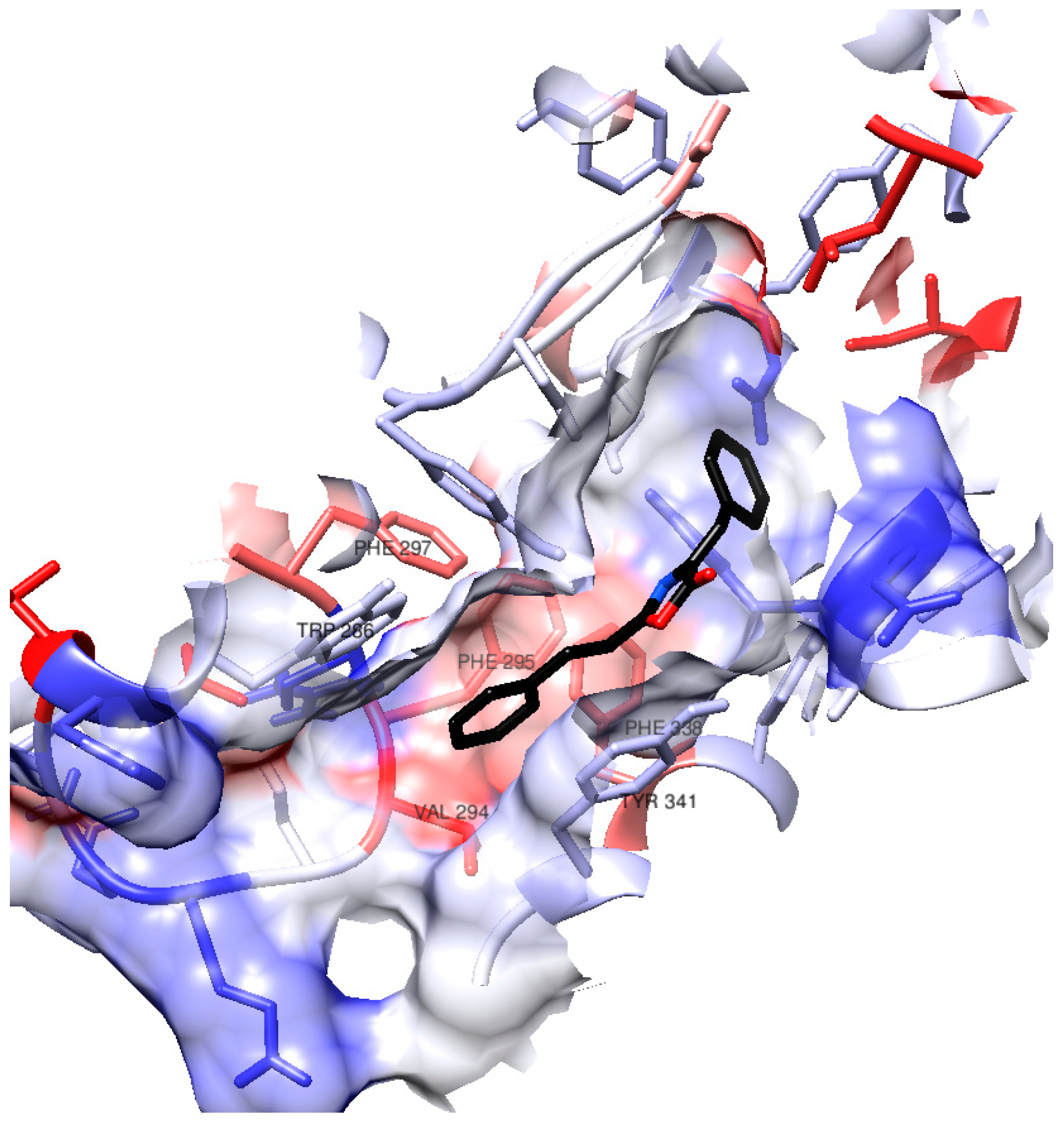
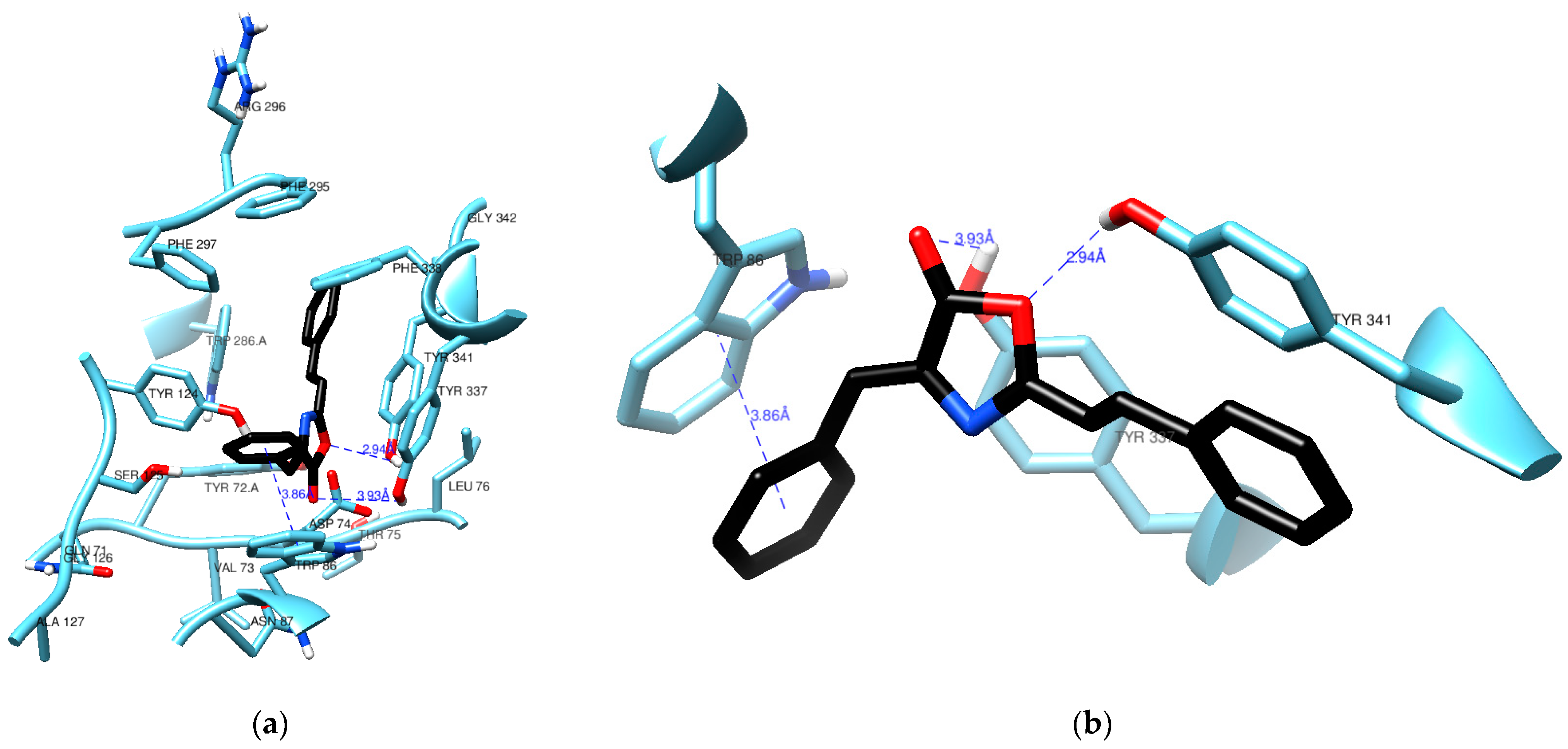
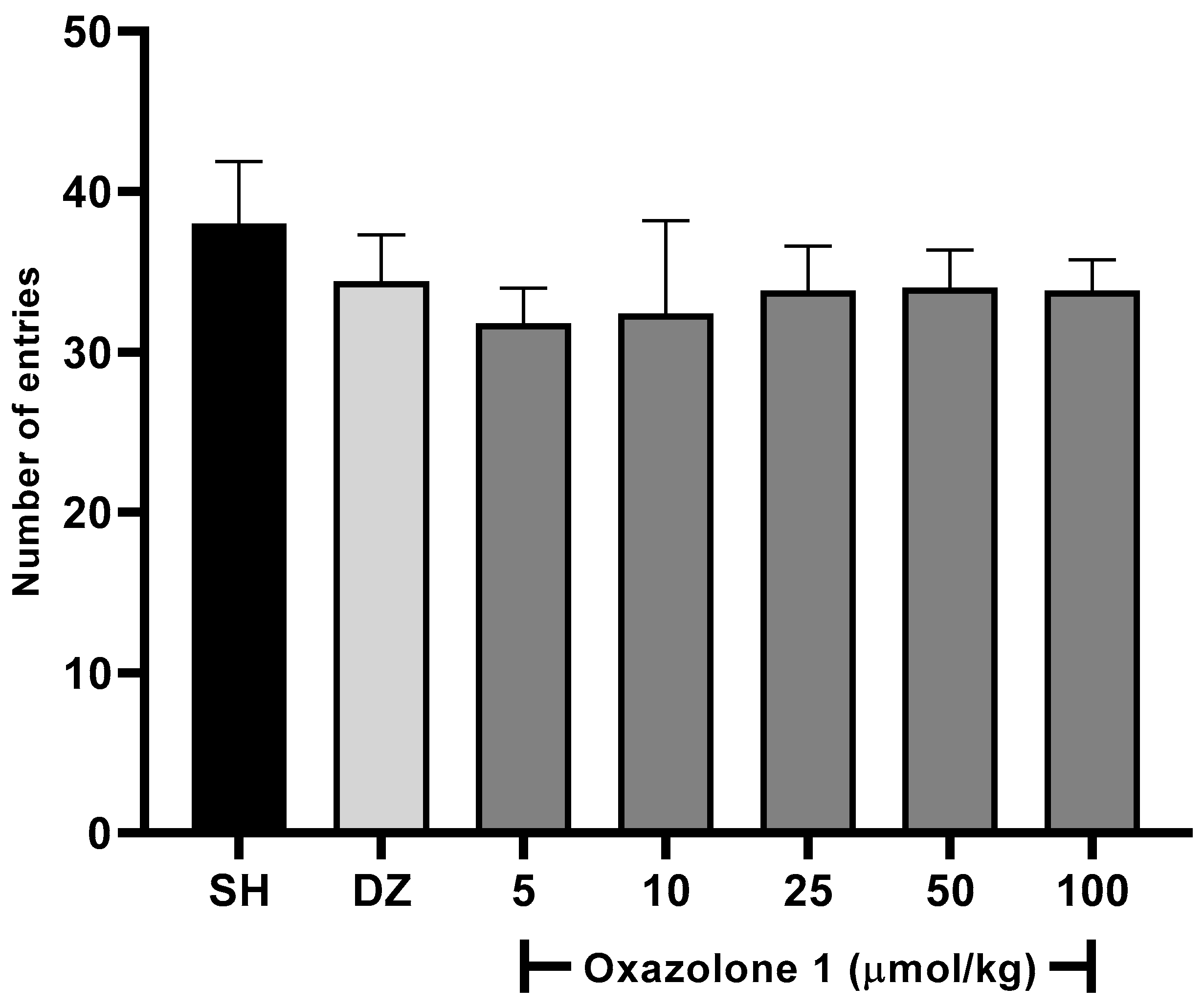
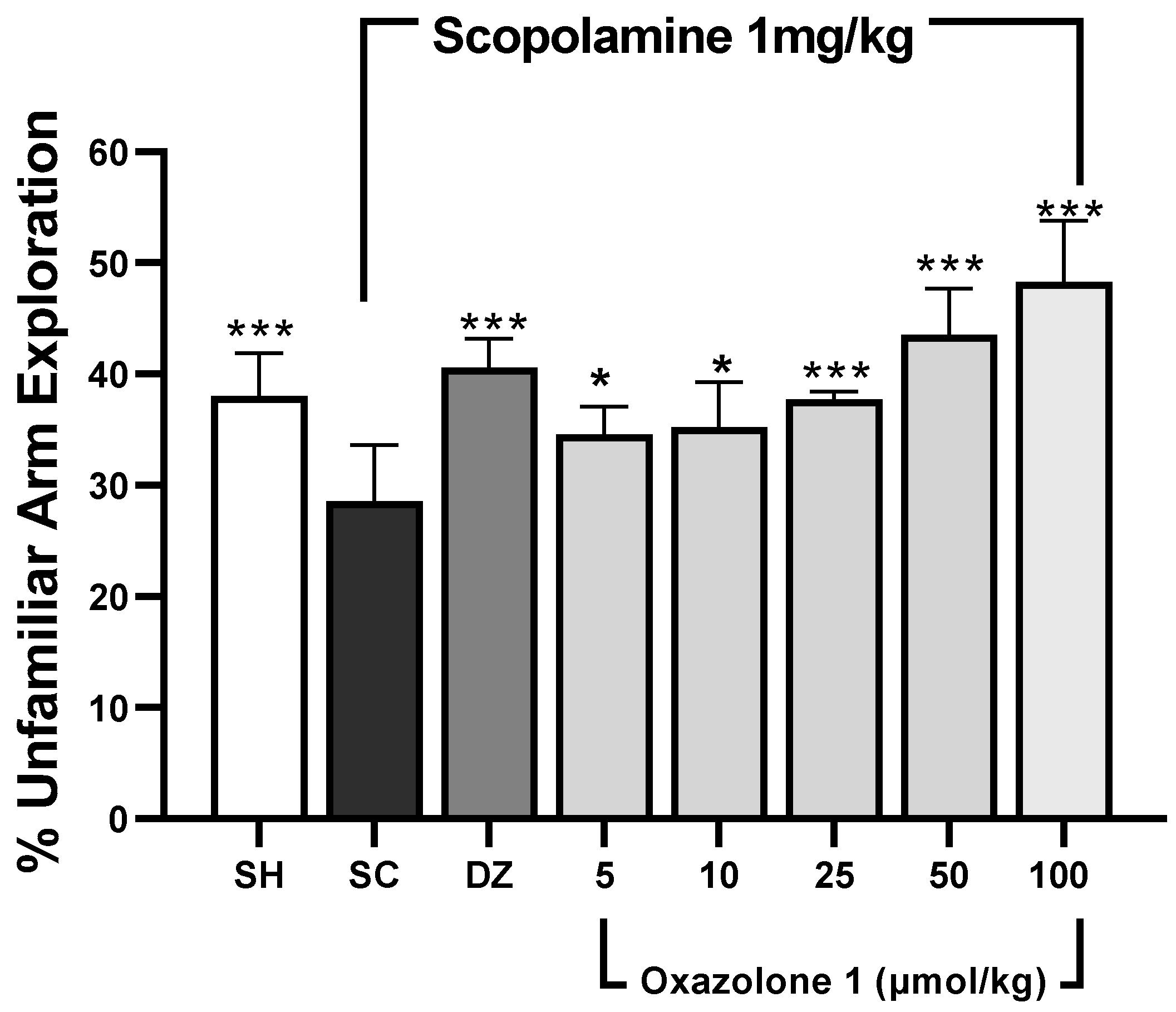
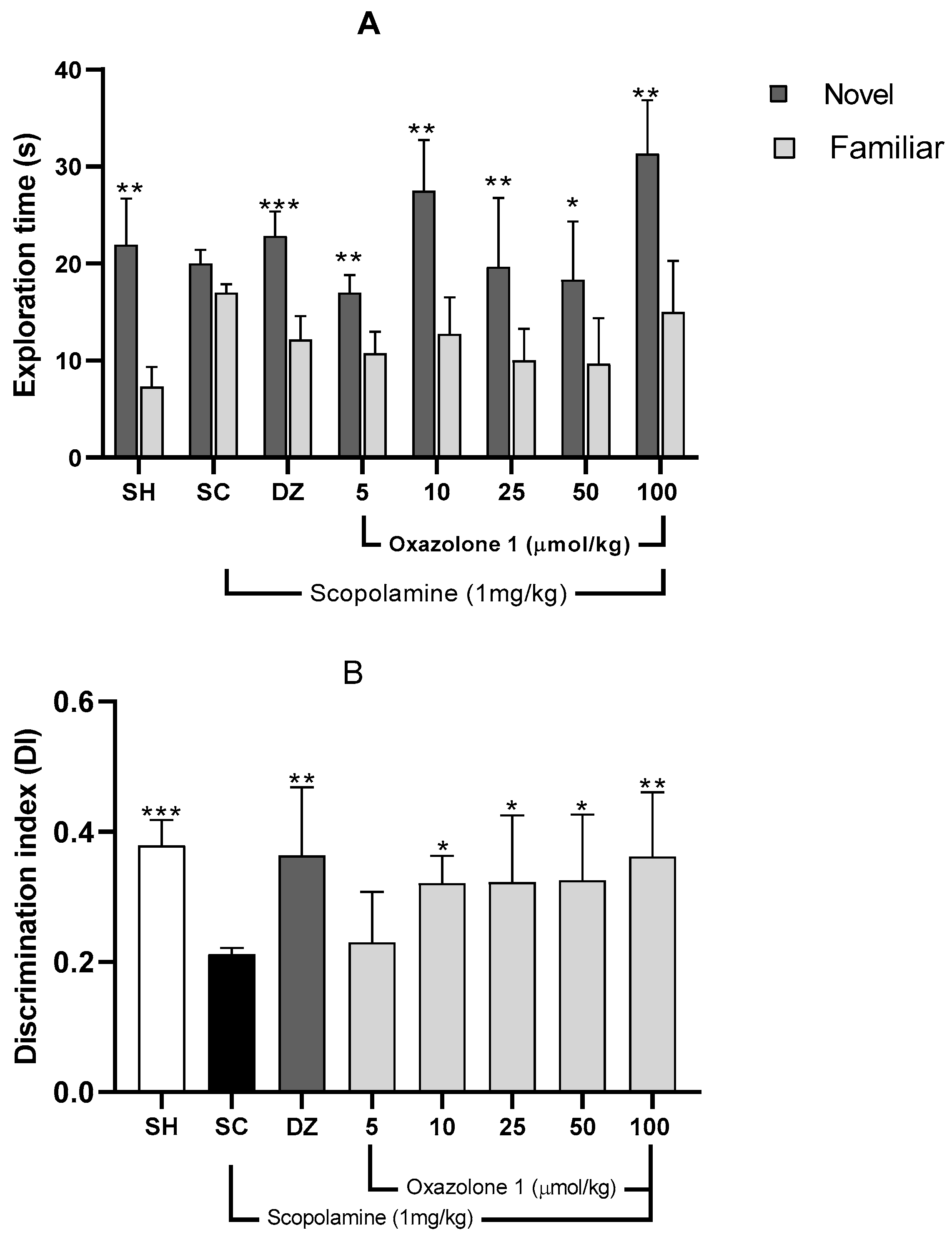
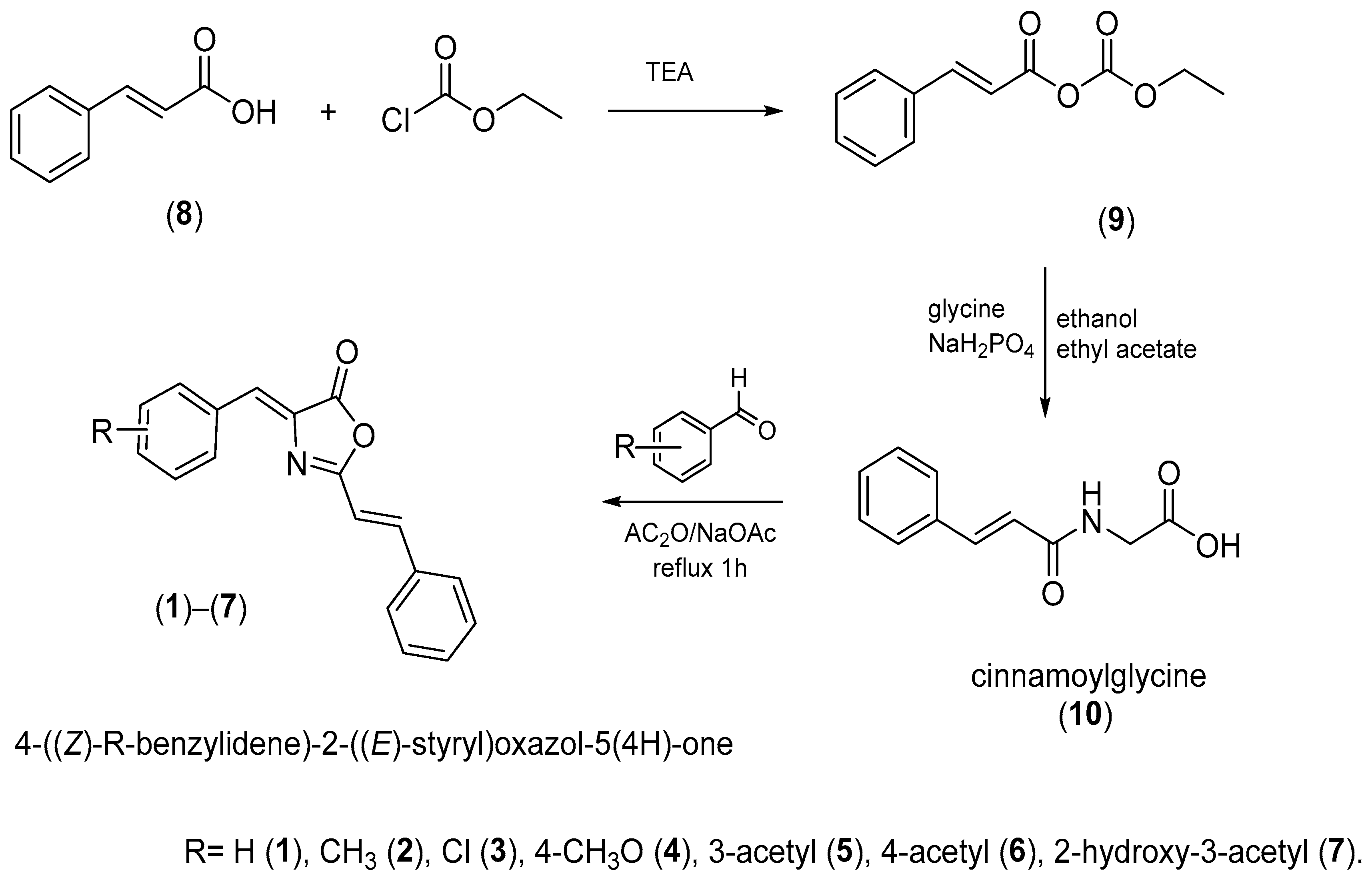
| Oxazolone | Inhibition Constant (Ki, μM) | IC50 (μM) | Parameter α | Mode of Inhibition |
|---|---|---|---|---|
| 1 | 2.08 ± 0.36 | 9.2 ± 2.3 | 21.84 | Competitive |
| 2 | 108 ± 7.77 | 95.48 ± 1.47 | 4.98 | Competitive |
| 3 | 98.39 ± 24 | 89.33 ± 22.33 | >1000 | Competitive |
| 4 | 156.9 ± 46 | 136.8 ± 34.2 | 4.16 | Competitive |
| 5 | 183 ± 46 | 203.9 ± 39.7 | 1 | Non-competitive |
| 6 | 198 ± 49.5 | 246.3 ± 51.2 | 0.006 | Mixed |
| 7 | 67 ± 19 | 37.10 ± 1.61 | 18.27 | Competitive |
| Binding Energy (kcal/mol) | ||
|---|---|---|
| Oxazolone | Full Enzyme | Active Site Only |
| 1 | −10.5 | −11.3 |
| 2 | −11.5 | −11.5 |
| 3 | −11.4 | −11.4 |
| 4 | −11.3 | −11.3 |
| 5 | −10.9 | −11.0 |
| 6 | −10.8 | −11.2 |
| 7 | −10.3 | −10.8 |
| a Donepezil | −12.1 | −12.3 |
| Descriptors | Oxazolone Compounds | ||||||
|---|---|---|---|---|---|---|---|
| (1) | (2) | (3) | (4) | (5) | (6) | (7) | |
| MW | 275.30 | 289.33 | 309.75 | 305.33 | 333.34 | 333.34 | 349.34 |
| Num. rotable bonds | 3 | 3 | 3 | 4 | 5 | 5 | 5 |
| Num. H-bond acceptors | 3 | 3 | 3 | 4 | 5 | 5 | 6 |
| Num. H-bond donors | 0 | 0 | 0 | 0 | 0 | 0 | 1 |
| TPSA (Å2) | 38.66 | 38.66 | 38.66 | 47.89 | 64.96 | 64.96 | 85.19 |
| Consensus Log P | 3.67 | 4.00 | 4.20 | 3.66 | 3.58 | 3.58 | 3.20 |
| Log S (Ali) | −4.50 | −4.88 | −5.16 | −4.67 | −4.80 | −4.80 | −4.85 |
| GI absorption | High | High | High | High | High | High | High |
| BBB permeant | Yes | Yes | Yes | Yes | Yes | Yes | No |
| P-gp substrate | No | No | No | No | No | No | No |
| CYP1A2 inhibitor | Yes | Yes | Yes | Yes | Yes | Yes | Yes |
| CYP2C19 inhibitor | Yes | Yes | Yes | Yes | Yes | Yes | No |
| CYP2C9 inhibitor | Yes | Yes | Yes | Yes | Yes | Yes | Yes |
| CYP2D6 inhibitor | No | No | No | No | No | No | No |
| CYP3A4 inhibitor | No | No | No | No | No | No | No |
| Lipinski Num. violations | 0 | 0 | 0 | 0 | 0 | 0 | 0 |
Disclaimer/Publisher’s Note: The statements, opinions and data contained in all publications are solely those of the individual author(s) and contributor(s) and not of MDPI and/or the editor(s). MDPI and/or the editor(s) disclaim responsibility for any injury to people or property resulting from any ideas, methods, instructions or products referred to in the content. |
© 2023 by the authors. Licensee MDPI, Basel, Switzerland. This article is an open access article distributed under the terms and conditions of the Creative Commons Attribution (CC BY) license (https://creativecommons.org/licenses/by/4.0/).
Share and Cite
Ramírez-Ruiz, A.M.; Ávila-Cossío, M.E.; Estolano-Cobián, A.; Cornejo-Bravo, J.M.; Martinez, A.L.; Córdova-Guerrero, I.; Cota-Ramírez, B.R.; Carranza-Ambriz, K.P.; Rivero, I.A.; Serrano-Medina, A. Inhibitory Activity of 4-Benzylidene Oxazolones Derivatives of Cinnamic Acid on Human Acetylcholinesterase and Cognitive Improvements in a Mouse Model. Molecules 2023, 28, 7392. https://doi.org/10.3390/molecules28217392
Ramírez-Ruiz AM, Ávila-Cossío ME, Estolano-Cobián A, Cornejo-Bravo JM, Martinez AL, Córdova-Guerrero I, Cota-Ramírez BR, Carranza-Ambriz KP, Rivero IA, Serrano-Medina A. Inhibitory Activity of 4-Benzylidene Oxazolones Derivatives of Cinnamic Acid on Human Acetylcholinesterase and Cognitive Improvements in a Mouse Model. Molecules. 2023; 28(21):7392. https://doi.org/10.3390/molecules28217392
Chicago/Turabian StyleRamírez-Ruiz, Alma Marisol, Martha Elena Ávila-Cossío, Arturo Estolano-Cobián, José Manuel Cornejo-Bravo, Ana Laura Martinez, Iván Córdova-Guerrero, Bibiana Roselly Cota-Ramírez, Krysta Paola Carranza-Ambriz, Ignacio A. Rivero, and Aracely Serrano-Medina. 2023. "Inhibitory Activity of 4-Benzylidene Oxazolones Derivatives of Cinnamic Acid on Human Acetylcholinesterase and Cognitive Improvements in a Mouse Model" Molecules 28, no. 21: 7392. https://doi.org/10.3390/molecules28217392
APA StyleRamírez-Ruiz, A. M., Ávila-Cossío, M. E., Estolano-Cobián, A., Cornejo-Bravo, J. M., Martinez, A. L., Córdova-Guerrero, I., Cota-Ramírez, B. R., Carranza-Ambriz, K. P., Rivero, I. A., & Serrano-Medina, A. (2023). Inhibitory Activity of 4-Benzylidene Oxazolones Derivatives of Cinnamic Acid on Human Acetylcholinesterase and Cognitive Improvements in a Mouse Model. Molecules, 28(21), 7392. https://doi.org/10.3390/molecules28217392









